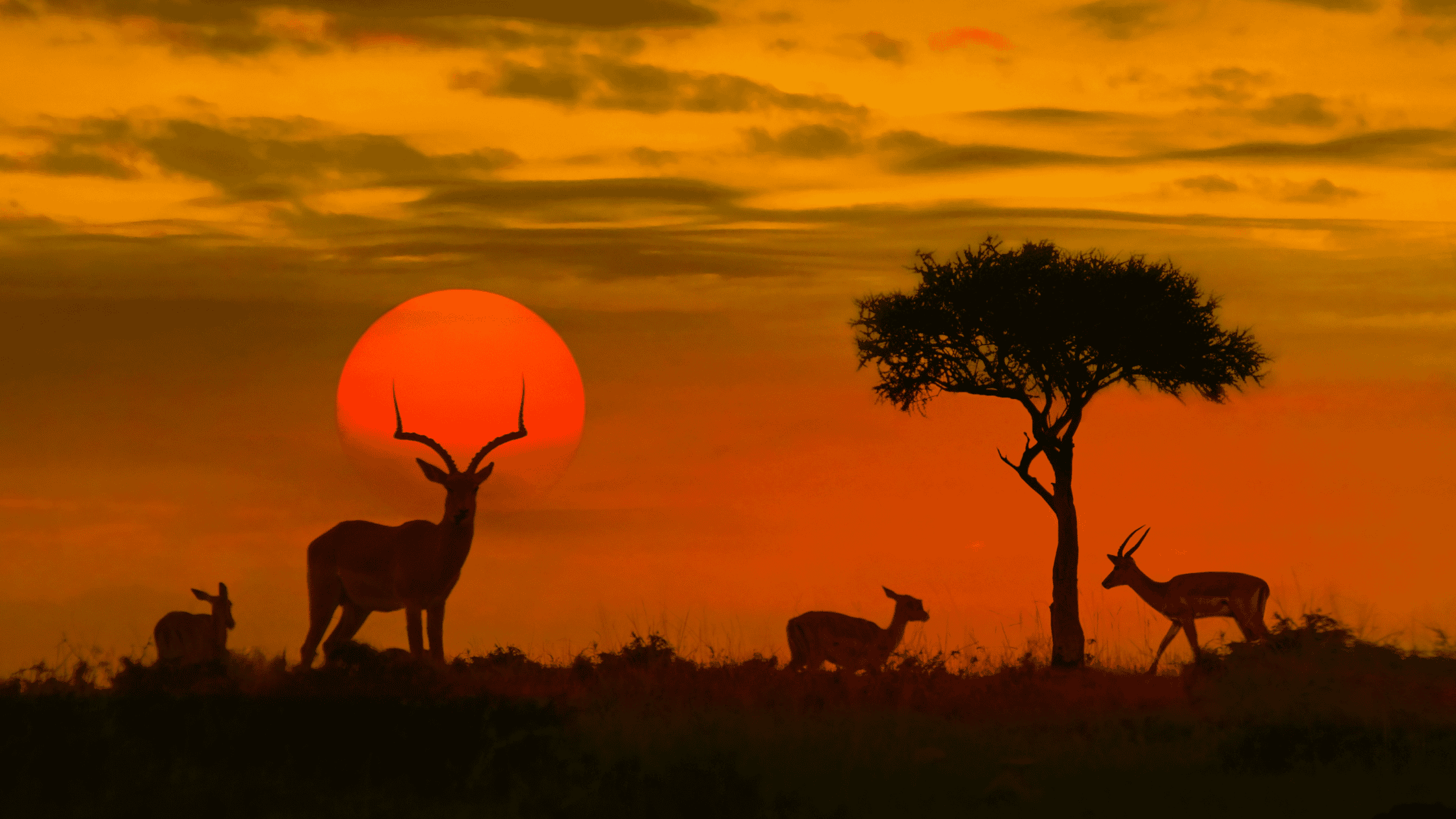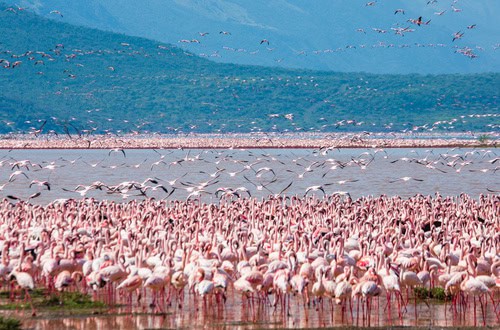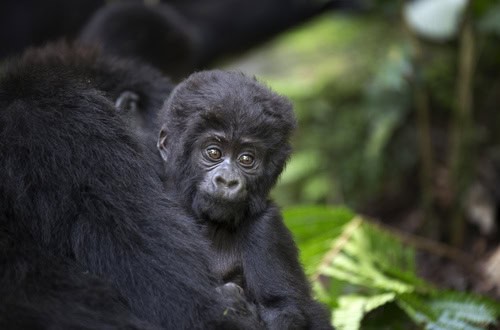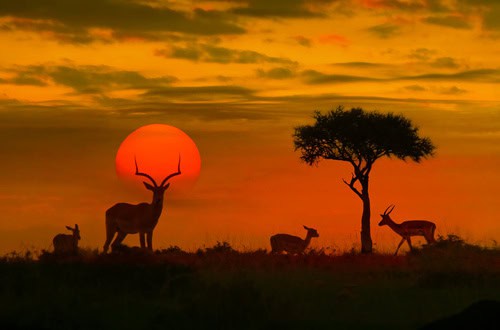


Africa is a vast continent of incredible contrasts, where each new moment is a fresh source of wonder and delight. From the sun-drenched savannas of Tanzania’s Serengeti to the mist-shrouded summit of Cape Town’s towering Table Mountain, these are ten of the most extraordinary experiences in East and Southern Africa:

Flock of flamingos at Lake Nakaru, Kenya
Nestled in the heart of Kenya’s Great Rift Valley, Lake Nakuru is famous for the immense flocks of flamingos which transform the lake’s shoreline into a flamboyant sea of pink. These graceful birds gather in their thousands to feed on the lake’s abundant algae, creating a breathtaking spectacle that is a wildlife photographer’s dream.
Lake Nakuru is one of Africa’s best birdwatching destinations – as well as flamingos, it’s home to pelicans, herons, fish eagles and other species. In addition, there are more than 50 mammal species, including lions, leopards, buffaloes, giraffes and rhinos.
Part of the Africa’s Great Rift Valley, Lake Nakuru National Park is a geological wonderland of alkaline soda lakes and hot springs, rocky cliffs and the stunning Makalia Falls. It’s located just a few hours’ drive from Nairobi and offers a range of accommodation options from luxury lodges to budget-friendly campsites.
East Africa’s Maasai tribe are a traditionally semi-nomadic and pastoral people who live by herding cattle and goats across immense areas of southern Kenya and Tanzania. Despite the impact of colonisation, they have preserved many of their ancient practices and ways of life, which you can experience during a guided visit to a Maasai village.
You’ll witness aspects of their daily lives, ceremonies, and rituals firsthand, from traditional methods of cattle herding to the use of local herbs in their medicinal practices and the construction of their distinctive mud-and-thatch homes known as enkangs. Traditional performances of rhythmic singing, chanting and dancing are both entertaining and deeply symbolic: for example, the adumu or “jumping dance” is a display of Maasai warriors’ athletic prowess.
Purchasing authentic Maasai jewellery, textiles and other crafts as souvenirs of your time in Kenya is a fantastic way to support local education, healthcare and other community projects.
Set in the leafy suburb of Langata on the outskirts of Nairobi, Giraffe Manor is one of Kenya’s most iconic and unique boutique luxury hotels. The picturesque manor house, with its mullioned windows and cloak of ivy, looks like it belongs in the English countryside. However, the hotel’s resident herd of Rothschild giraffes – who roam freely around the property and may pop their head through an open window while you’re enjoying your breakfast – ensures that your stay here is distinctly African.
Giraffe Manor is part of The Safari Collection, which is committed to supporting local communities and plays a crucial role in the conservation of Rothschild giraffes. You can learn about their conservation efforts during a visit to the nearby Giraffe Centre, where you can feed and interact with the giraffes while learning more about this endangered subspecies.
From the wide-open plains of Serengeti National Park, Africa’s highest mountain – often topped with a light dusting of snow – is an unmissable landmark. Kilimanjaro is one of the world’s most iconic peaks, and although the climb is challenging, you don’t need to be a skilled mountaineer to experience the thrill of reaching to its 5,895-metre summit.
There are several routes to choose from, each offering different challenges and scenic views. It typically takes around nine days to reach the top and return: the longer you spend on the mountain, the more time you will have to adjust to the altitude. Along the way, you will pass through a variety of ecosystems, from lush rainforests that are home to colobus monkeys and vibrant birdlife, through moorlands and alpine deserts, and finally, glacial icefields near the summit. One of the most memorable aspects of climbing Kilimanjaro is the chance to witness the spectacular sight of the sun rising over the African plains from high on the mountain – it’s a truly magical experience.
Professional guides and support teams will accompany you on your climb, ensuring that you are well-prepared, well-provisioned and well-informed for a successful and safe adventure. They will provide invaluable knowledge about the mountain, prepare delicious meals and carry essential gear, and provide expertise and encouragement throughout the experience. The climbing season is based on the dry season months: December to early March and June to October.

Gorilla Trekking in Uganda
Located in southwestern Uganda, Bwindi Impenetrable Forest is one of Africa’s most captivating natural wonders. This UNESCO World Heritage Site is renowned for its dense vegetation and rich biodiversity, offering a unique and unforgettable experience for nature enthusiasts, wildlife lovers, and adventure seekers.
Bwindi is home to about half of the world’s remaining mountain gorillas, and a guided trek to see these majestic creatures in their natural habitat is truly a once-in-a-lifetime, bucket-list moment. You will be led through dense cloud forest to observe gorilla families up close; witnessing their behaviour and interactions is a profoundly moving experience.
Along the way, you will encounter an extraordinary diversity of flora and fauna. The forest is home to over 350 bird species, many of them endemic to the Albertine Rift region, as well as 200 butterfly species, and numerous mammals including forest elephants, duikers, and monkeys. The best time of year to visit Bwindi is during the dry season: June to August and mid-December to February.
One of the Seven Natural Wonders of the World, Victoria Falls is a breathtaking destination that straddles the border between Zambia and Zimbabwe. The largest waterfall in the world by combined width (1,708 metres) and height (108 metres), the sheer volume of water cascading over the edge creates a thunderous roar and a mist that can be seen from miles away. This phenomenon has earned the falls their local name, Mosi-oa-Tunya, (“The Smoke That Thunders”). The sight is nothing short of spectacular, particularly during the rainy season when the Zambezi River is in full flow.
The falls are renowned not just for their stunning beauty and immense power, but also for the multitude of thrilling activities on offer. You can experience the thrill of bungee jumping off the Victoria Falls Bridge, zip-lining across the Batoka Gorge or white-water rafting on the Zambezi River – considered one of the best rafting experiences in the world. For a truly heart-pounding experience, take a heart-stopping dip in the Devil’s Pool: a natural infinity pool that’s set right on the edge of the falls.
A scenic helicopter flight, known as the “Flight of Angels,” provides an incredible aerial perspective of the falls, the Zambezi River gorge, and the surrounding landscape. It’s a great way to appreciate the scale and beauty of this natural wonder from a unique perspective.

Wildlife Safari in Kruger National Park, South Africa
One of the largest and most renowned game reserves in southern Africa, with nearly 20,000 square kilometres of dense bushveld, open savannas, riverine forests and rocky outcrops that support an incredibly diverse wildlife population. The classic “Big Five” (lion, leopard, elephant, buffalo, and rhino) are accompanied by cheetahs, giraffes, hippos and zebras, as well as more than 500 bird species.
Kruger offers something to suit every taste and budget, ranging from simple safari camps to luxurious private lodges. You can opt for game drives in open 4×4 vehicles or small group walking safaris led by skilled guides. You’ll gain valuable insights into animal behaviour and ecology from the park’s experienced rangers, as well as learning about local conservation and education initiatives.
From May to September, Kruger’s dry season draws animals to congregate around water sources, making them easier to spot. The wet season (October to April), when the rains turn the landscape to a spectacular, lush green, is the best time to witness spectacular bird migrations and newborn animals.
Located in South Africa’s Western Cape, Stellenbosch is one of the most famous and picturesque wine regions in the world, renowned for the historic charm and world-class wines produced by more than 150 wine estates.
The region’s Mediterranean climate and varied terroirs allow for the production of a wide range of wine styles, which include its signature Pinotage as well as robust Cabernet Sauvignon, crisp Chenin Blanc and spicy Shiraz.
The Stellenbosch wine route is a stunning landscape of rolling vineyards, majestic mountains, and Cape Dutch architecture – the ideal setting for an outdoor tasting. You can join a guided tour that offers insights into the region’s wine industry and history, or take a cellar tour that follows the winemaking process from grape to bottle, ending at your own tasting glass.
Table Mountain is one of the most iconic natural landmarks in the world: a UNESCO World Heritage Site that offers breathtaking views, unique biodiversity, and a range of outdoor activities. With its instantly recognisable flat top, often blanketed in a layer of cloud that is lovingly referred to as “the tablecloth”, Table Mountain is a symbol of Cape Town and a testament to the immense natural beauty of South Africa.
The Table Mountain Aerial Cableway is a popular way to reach the summit, equipped with rotating cable cars that allow you to enjoy jaw-dropping, 360-degree views without raising a sweat. If you are feeling more energetic, you can opt for a vigorous hike to the summit instead – there are numerous trails of varying difficulty to choose from, including Platteklip Gorge and Skeleton Gorge.
Table Mountain is part of the Cape Floristic Region, which is renowned for its rich biodiversity. The mountain is home to over 1,500 plant species, many of which are endemic, as well as a variety of wildlife including rock hyraxes (dassies), lizards and numerous species of birds.
The Southern Namib is a vast dune sea with some of the tallest and most spectacular dunes in the world, ranging in colour from pink to vivid orange. In the Sossusvlei area, Dune 45 and Big Daddy are among the most well-known dunes, reaching more than 300 metres above the desert floor and offering incredible photo opportunities, especially at sunrise or sunset.
Test your skills at sandboarding, explore the desert by quad bike or take a hot air balloon ride over the desert at dawn. Regardless of your preferred level of adventure, the panoramic views of the dunes and the vast desert landscape are always breathtaking.
With its vast open spaces, minimal light pollution and pristine air quality, the Namib Desert provides idyllic conditions for observing the night sky. The drier winter months of May to September offer the best conditions for stargazing, with skies that are typically clear and cloud-free. Some lodges and campsites offer telescopes and other equipment to help you get a closer look at the night sky, or you can join a guided star-gazing tour with a knowledgeable guide who will share insights into the constellations, planets and celestial phenomena.
The renowned naturalist, Jane Goodall, wrote, “the sunrises and sunsets over the vast plains, the incredible diversity of wildlife, the vibrant cultures of the people – Africa is a tapestry of beauty and wonder that never ceases to amaze.”
To create an African holiday that’s packed with amazing animal encounters and astonishing cultural experiences, contact your local personal travel manager.